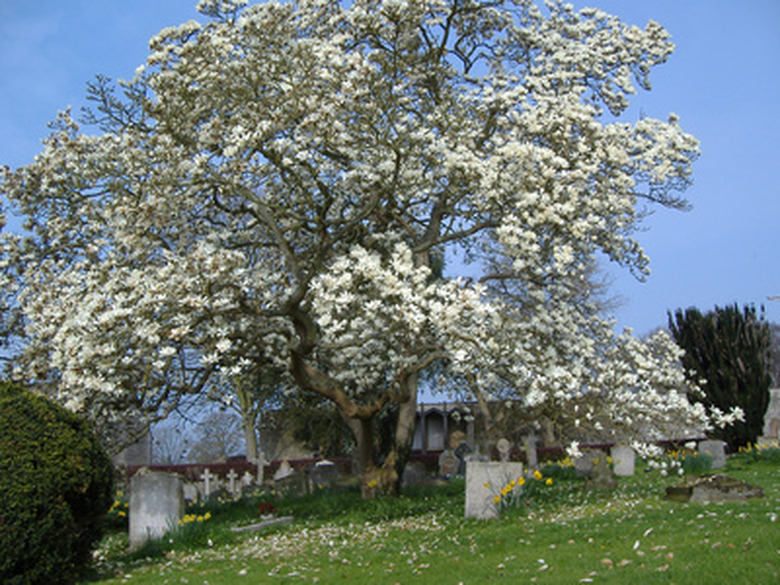Black Mold With Flies On A Magnolia Tree
A mature magnolia tree in full bloom commands attention from every quarter. The large, white blooms of Southern magnolias (Magnolia grandiflora) that perfume the spring air with their fragrance have become symbolic of gracious Southern living. When one of these–or any magnolia species–tree develops a coating of fly-covered black mold, however, its beauty is quickly forgotten. Magnolia lovers will be glad to learn that this disfiguring condition is treatable.
Causes
Magnolia trees suffer attacks of scale insects before they develop black mold. Up to 1/2 inch across, the soft-bodied scale insects feed on magnolias throughout the Eastern United States, say Penn State University Extension's program assistant Katherine Mazzey and extension agent Michael Masiuk. Wintering as larvae on older twigs, they develop syringe-like mouth tubes to suck fluids from the foliage. After feeding, the insects excrete a sticky, sweet waste product called honeydew that coats the tree's leaves, branches and trunks. Black mold infests the trees to feed on the honeydew.
- A mature magnolia tree in full bloom commands attention from every quarter.
- Wintering as larvae on older twigs, they develop syringe-like mouth tubes to suck fluids from the foliage.
Features
Black mold — officially known as sooty mold — is a fungus composed of microscopic threads. In large numbers, the threads create visible black patches. In very large numbers, they cover wide areas of honeydew with a charcoal gray coating. In some instances, sooty mold will peel off affected plants in tissue-like sheets, say North Carolina University Extension entomologist Steven D. Frank and colleagues.
Considerations
Like all sugar-rich substances, honeydew attracts its share of insects, including flies, ants, and wasps. Magnolia trees coated with honeydew may simultaneously attract black mold and flies, giving the unplesant impression that the flies are feeding on the fungus. They aren't.
- Black mold — officially known as sooty mold — is a fungus composed of microscopic threads.
- Magnolia trees coated with honeydew may simultaneously attract black mold and flies, giving the unplesant impression that the flies are feeding on the fungus.
Effects
Because black mold feeds on honeydew, it doesn't directly damage magnolia trees. It may, however, cause secondary damage by covering the foliage and blocking out light necessary for photosynthesis. Because the scale insects have already damaged the leaves, the magnolias may become weak and suffer from branch dieback.
Control
Keeping black mold and flies away from magnolia trees is a matter of managing the scale insects that produce honeydew. Managing scale, however, requires patience. It may be a multi-year undertaking. Using insecticide is effective only when the larvae are crawling in search of leaves to feed on. Feeding insects produce a protective waxy substance, note NCSU's Frank and colleagues.
- Because black mold feeds on honeydew, it doesn't directly damage magnolia trees.
- Because the scale insects have already damaged the leaves, the magnolias may become weak and suffer from branch dieback.
Horticultural oils, dormant oils, and insecticidal soaps and sprays treat scale. Horticultural oils suffocate larvae overwintering on the trees. Dormant oils treat scale between late winter and summer, depending on variety. Their manufacturers provide guidance on temperature restrictions and plant sensitivity.
Insecticidal soaps require direct contact with the insects. Imadacloprid is a systemic insecticide. Applied to the soil around a magnolia, it enters the root system and spreads to the leaves. Insects ingesting it die. Applying it several weeks before the larvae begin migrating may optimize its effects.
- Horticultural oils, dormant oils, and insecticidal soaps and sprays treat scale.
- Insecticidal soaps require direct contact with the insects.
